| |
| |
We’ve all heard and read about the dinosaurs. We know the extinction theories, and you may even have your own. However, there were thousands of other creatures living amongst the dinosaurs that you may not know about. Some look like animals you would find in the zoo or aquarium today, while others are extremely bizarre and down right scary looking. In any case, they’re all millions of years old and, thankfully, extinct.
Below is a list of the weirdest ten prehistoric animals: some are not-so-popularly known dinosaurs, some are small, and some are bigger than the average man. Through the helpful skills and knowledge of archaeologists, more and more prehistoric animals are found every year.
10. Dunkleosteus
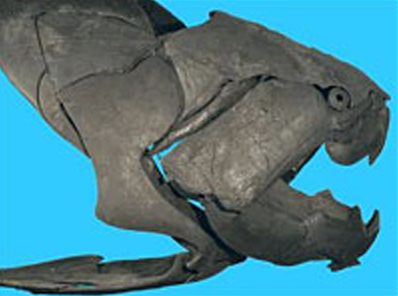
The Dunkleosteus is a prehistoric fish that could give you nightmares. It’s said to be one of the biggest arthrodire placoderms, an armored and jawed fish, to have ever grazed Earth’s waters. It was about 33 feet long and weighed almost 4 tons. The creature is considered to be hypercarnivorous as well as an apex predator. This means that the Dunkleosteus wasn’t a prey to any other type of animal, and mainly consumed meat as its diet. Though a meat eater, the creature didn’t have teeth, instead its mouth held two pair of gnathal plates, which formed a beak like structure. Using these plates, it is said that the Dunkleosteus had a bite similar to one of a crocodile, or even a T-Rex, able to place 8,000 pounds per square inch of pressure on a victim. Thankfully this creature died during the Late Devonian period, or else swimming in the ocean would be a bit scary.
Ancient Ancestors
While it is said that after the Late Devonian period, no other creature existed that was a direct relation to the Dunkleosteus, another prehistoric fish did eventually come about, known as the Titanichthys. However, this fish is still seen as ancient to us. Because the Dunkleosteus is no direct ancestor of animals today, many researchers broadly consider them to be 400 billion year old sharks, so modern day sharks may be related to this creature.
9. Archaeopteryx
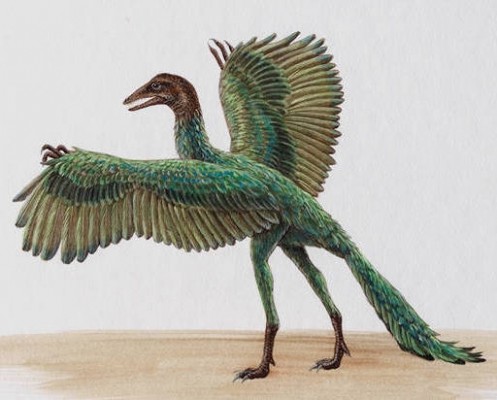
The Archaeopteryx, sometimes known as the first bird, is what scientists believe is the most primitive bird to have ever existed. The creature lived during the late Jurassic Period in a southern region of present-day Germany, at a time when Europe was nothing but an archipelago of islands. It is said that the prehistoric animal was only the size of the common magpie we all know today, which is about 1.6 feet in length. However, while the Archaeopteryx was petite, full of feathers, and seemed harmless; the creature actually had extremely broad wings and razor sharp teeth. It also had claws located on the fingers and the second toes. The toe claws were hyper-extensible into something referred to as the ‘killing claw’.
Ancient Ancestors
Scientific research has found that the Archaeopteryx is more related to dinosaurs than to birds. With this said, scientists believe that this creature may be the first of its kind, starting a new generation of animals that were dinosaurs, but were the first to change from land-roaming animals to those that were able to fly and eventually become birds. When looking at links, it’s safe to say that the Archaeopteryx is probably related to all birds today, as it is the first-known example of flight feathers.
8. Elasmosaur
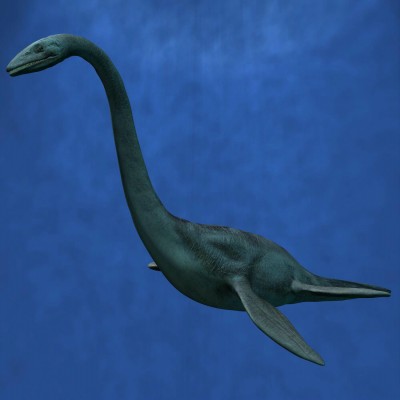
The Elasmosaur lived during the Late Cretaceous period. It was probably around 46 feet in length and weighed over 2.2 tons. Half of its body’s length was its neck, which had over 70 vertebrae, which is more than any known animal today. However, its long neck was highly important as it was the only part of its body that was able to be lifted out of the water. With such a large body, you’d think that the creature had large flippers, but according to fossils found in Kansas by Dr. Theophilus Turner, it had four that weren’t of great size. Its body was accompanied by a small head that held extremely sharp teeth.
Ancient Ancestors
The Elasmosaur doesn’t have any close relations to animals that you’d find in today’s world, but it can be generalized that it is somewhat related to reptiles. Though it doesn’t have any close ties, if you’re a believer of the Loch Ness monster, then the Elasmosaur is definitely your pal. It’s said that most stories involve an animal that is extremely similar to this creature.
7. Deinotherium
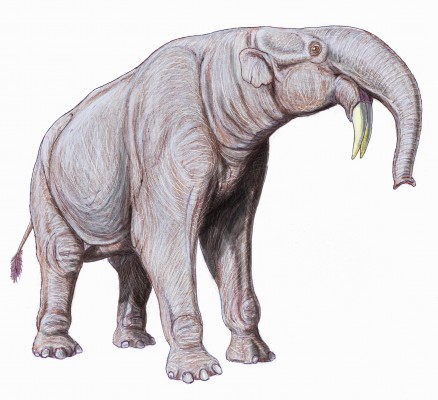
At times known as the ‘hoe tusker’, the Deinotherium was a creature that lived during the Middle Miocene era and died sometime during the Early Pleistocene era. It’s also known as being the third largest land animal to have ever existed, standing about 15 feet tall and weighing over 15.4 tons. The creature looks much like present-day elephants, the only real difference being that they had a shorter trunk and the tusks were attached to the lower jaw, not the upper jaw like today’s elephants. Deinotherium fossils have been found all over, mainly in Europe, Asia, and Africa. After these fossils were found, many believe that the large teeth and tusks were the catalysts to Greek beliefs of giant archaic creatures.
Ancient Ancestors
Just by looking at the Deinotherium, you can correctly assume that they are more than likely ancestors of the elephants you see today. The creature is also said to be related to the gomphotheres as well as the mastodons, both of which are extinct creatures.
6. Opabinia
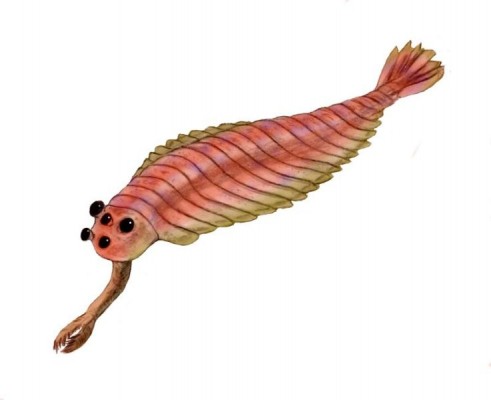
Opabinia is one of the rarest fossils found in today’s world. There are less than twenty quality specimens of the creature, and archaeologists hope to discover more in time. The known fossils were mostly found in the Burgess Shale of British Columbia. Opabinia isn’t what you’d expect when you think about prehistoric ages. This species, known to live on the seafloor, had a soft body that was about seven centimeters long. They had a head with five eyes and a mouth underneath that was backwards. The backwards mouth is said to coincide with the fact that the creature had a proboscis, which was more than likely used to pass food to the mouth, as its length indicates. The creature also had a segmented body that was finished off by a fan-shaped tail.
Ancient Ancestors
When the Opabinia fossils were first discovered, scientists did not believe that the species was related to any known type of phylum at the time, but after numerous studies of the fossils, many believe that the species is related to arthropods as well as amenlid worms. Scientists also believe that the Opabinia is an ancestor of those creatures found in the onychophorans and tardigrades group.
5. Helicoprion
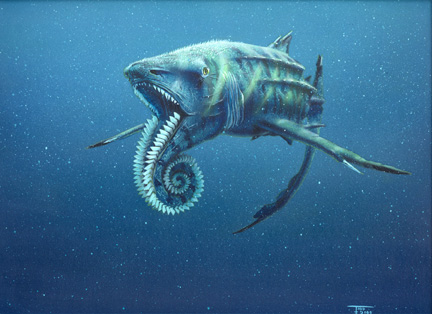
Known as the Spiral Saw, the Helicoprion is said to have lived during the Carboniferous period and was one of the few creatures able to live through the Permian-Triassic extinction event (‘The Great Dying’). Eventually the Helicoprion went extinct during the Triassic period. Though not many fossils have been found, archaeologists have found the tooth-whorl as well as jaw bones. With these, researchers have pieced together ideas of what the Helicoprion may have looked like. One thing we know for sure is that the creature had teeth that are very much like a circular saw, which was connected on the lower jaw. It had so many teeth because as new teeth grew, the older teeth were pushed out and into the middle to create the spiral. Length-wise the creature was said to be 10-15 feet.
Ancient Ancestors
The Helicoprion was said to be extremely shark-like, having cartilage, fins, and razor sharp teeth. In fact, some believe that the creature was a shark itself, but there is not enough evidence to prove this.
4. Quetzalcoatlus
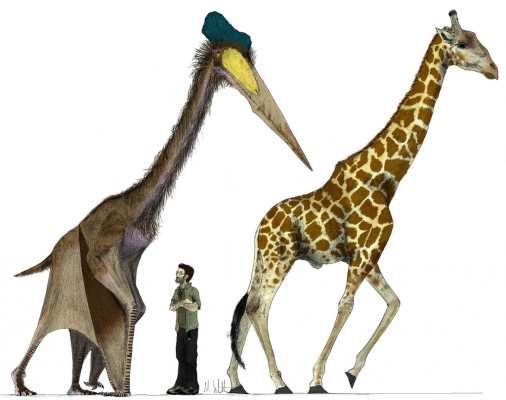
The Quetzalcoatlus is said to be one of the largest, if not the largest creature, to ever roam the skies. The name comes from a reference to an Aztec god, Quetzalcoatl, who was known for being a feathered serpent. Known for living in the Late Cretaceous period, the pterodactyloid pterosaur was King of the Skies, spreading its wings to a span of up to 36 feet and standing almost 32 feet. The creature had a very pointy beak, which was used for collecting food, despite the fact that it had no teeth. The fossils were discovered and collected in Big Bend Park in Texas in 1971. It’s said that when on the ground, the animal was a quadruped, and that it had so much power that it could go straight into flight.
Ancient Ancestors
Comparing a huge creature like this to those in today’s world is definitely difficult. Since it was a pterosaur, the animal has no clear relatives living today. However, in its time it was most related to the Pteranodon, and today it can be compared to all living birds, most closely comparable is the Marabou stork. Many have compared the two due to the fact of it’s larger than normal wingspan, and the fact that both are said to scavenge for food.
3. Dimorphodon
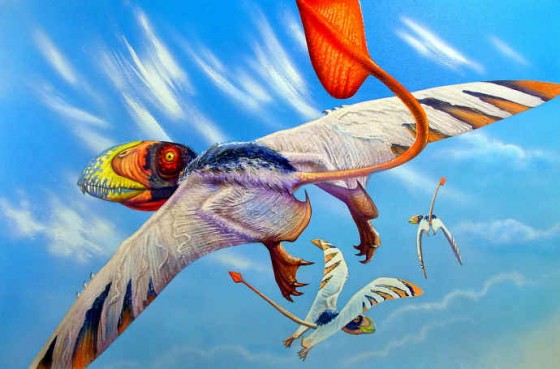
The Dimorphodon was a pterosaur of medium size said to live during the early Jurassic Period. Its fossils were found in Lyme Regis in Dorset U.K. in 1828. The pterosaur’s name comes from Greek words that mean “two-form tooth.” Richard Owen crafted the name for the creature, in hopes to focus on its rare distinction within the entire reptilian family. The creature had two different types of teeth in its jaws, which is rarely heard of when examining reptiles. The Dimophodon stood about 3.3 feet tall, with a small neck but large head, and had a wingspan of 4.6 feet. It had a tail that included 33 vertebrae which may or may not have been used as a balancing mechanism when walking, but was definitely used during flight. Scientists still debate whether or not it walked on four legs or just two. Painting by Luis Ray.
Ancient Ancestors
Today there are no closely linked ties as to what the Dimorphodon resembles or may be related to. In fact, scientists say that the Dimophodon, because it was a pterosaur, was barely related to the dinosaurs that we all know. It’s a possibility that it was related to the insect-eating anurognathid, but many disagree. It can be said that the creature is related to birds of all types due to it having wings.
2. Jaekelopterus
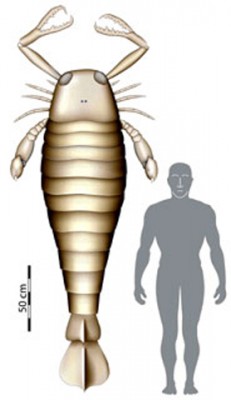
First found fossilized in Klerf Formation Lagerstätte of Willwerath near Prüm, Germany, the Jaekelopterus is one of the largest arthropods that have been discovered thus far. It is said that the creature was about 8.2 feet tall and lived in fresh water lakes and rivers. Though exact measurements aren’t clear, scientists did have measurements of the chelicera, which are claws in front of the head used to grip food; and from there estimated the entire size of the creature. The chelicera itself was 18 inches long.
Ancient Ancestors
It is said that the ancient ancestors are most related to the horseshoe crab, arachnids, and scorpions, and fits into a group called the Merostomata. There is proof in both shape and size that the Jaekelopterus is probably related to these present day creatures. But, many see the most resemblance in scorpions and the Merostomata, so the Jaekelopterus is sometimes called the sea scorpion.
1. Hallucigenia
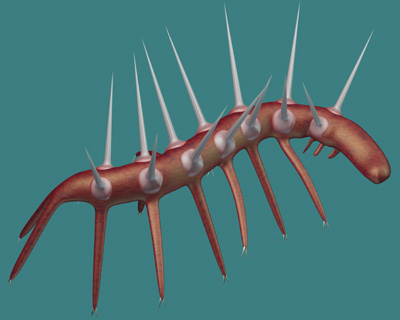
Hallucigenia fossils were first found in British Columbia, Canada; and more recently, in China. The name Hallucigenia comes from Simon Conway Morris, who was one of the first to take another look at the specimens that were already found by Charles Walcott. The name was derived from the idea that these creatures are extremely bizarre and have a dream-like quality to them, much like a hallucination. The creature was said to be from 0.5-3cm long and was very wormlike with a head that didn’t include most sensory organs we’d find today, such as the eyes and nose. Instead the Hallucigenia had seven pincer-tipped tentacles on each side of its body, and then three pairs of tentacles behind those. Some of these tentacles were paired with spines and it’s said that one had the main purpose of feeding the creature. Recent studies have shown both male and female species, the males having a more rounded head and neck while the females had the opposite.
Ancient Ancestors
It is said that Hallucigenia is a long time ancestor of modern day arthropods. Despite the fact that many believed the species was unrelated to any species today, it’s been said that they have very close ties to present-day arthropods as well as the Onychophora, also known as velvet worms.

Tidak ada komentar:
Posting Komentar